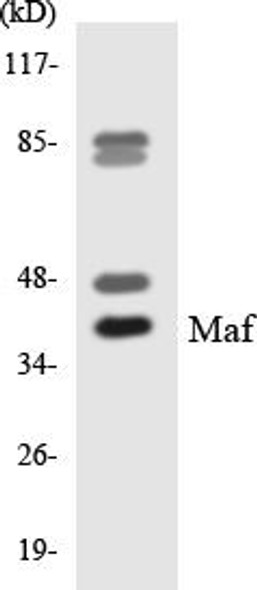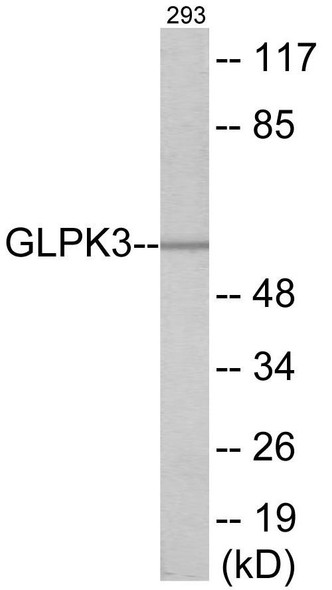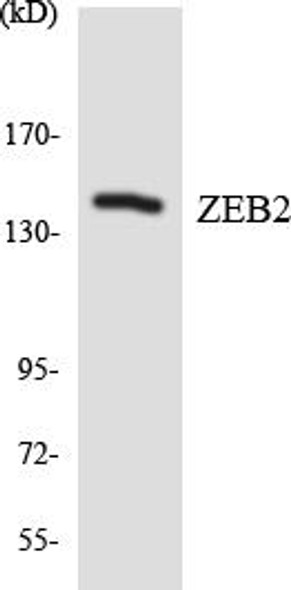SIAH1 Colorimetric Cell-Based ELISA
- SKU:
- CBCAB01148
- Product Type:
- ELISA Kit
- ELISA Type:
- Cell Based
- Research Area:
- Cell Death
- Reactivity:
- Human
- Mouse
- Rat
- Detection Method:
- Colorimetric
Description
SIAH1 Colorimetric Cell-Based ELISA
The SIAH1 Colorimetric Cell-Based ELISA Kit is specifically designed for the quantitative measurement of SIAH1 protein levels in cell lysates. This kit offers high sensitivity and accuracy, providing researchers with reliable and reproducible results for their studies.SIAH1 is a key regulator of the ubiquitin-proteasome pathway, playing a critical role in the degradation of target proteins involved in processes such as cell cycle progression, apoptosis, and cellular signaling.
Dysregulation of SIAH1 has been implicated in various diseases, including cancer, neurodegenerative disorders, and inflammatory conditions, highlighting its importance as a potential therapeutic target and biomarker for disease progression.With easy-to-follow protocols and high-quality reagents, the SIAH1 Colorimetric Cell-Based ELISA Kit is an essential tool for researchers investigating the role of SIAH1 in cellular processes and disease pathogenesis.
| Product Name: | SIAH1 Colorimetric Cell-Based ELISA |
| Product Code: | CBCAB01148 |
| ELISA Type: | Cell-Based |
| Target: | SIAH1 |
| Reactivity: | Human, Mouse, Rat |
| Dynamic Range: | > 5000 Cells |
| Detection Method: | Colorimetric 450 nmStorage/Stability:4°C/6 Months |
| Format: | 96-Well Microplate |
The SIAH1 Colorimetric Cell-Based ELISA Kit is a convenient, lysate-free, high throughput and sensitive assay kit that can detect SIAH1 protein expression profile in cells. The kit can be used for measuring the relative amounts of SIAH1 in cultured cells as well as screening for the effects that various treatments, inhibitors (ie siRNA or chemicals), or activators have on SIAH1.
Qualitative determination of SIAH1 concentration is achieved by an indirect ELISA format. In essence, SIAH1 is captured by SIAH1-specific primary antibodies while the HRP-conjugated secondary antibodies bind the Fc region of the primary antibody. Through this binding, the HRP enzyme conjugated to the secondary antibody can catalyze a colorimetric reaction upon substrate addition. Due to the qualitative nature of the Cell-Based ELISA, multiple normalization methods are needed:
| 1. | A monoclonal antibody specific for human GAPDH is included to serve as an internal positive control in normalizing the target absorbance values. |
| 2. | Following the colorimetric measurement of HRP activity via substrate addition, the Crystal Violet whole-cell staining method may be used to determine cell density. After staining, the results can be analysed by normalizing the absorbance values to cell amounts, by which the plating difference can be adjusted. |
| Database Information: | Gene ID: 6477/6478, UniProt ID: Q8IUQ4/O43255, OMIM: 602212/602213, Unigene: Hs.706828/Hs.477959/Hs.692394 |
| Gene Symbol: | SIAH1/2 |
| Sub Type: | None |
| UniProt Protein Function: | SIAH1: E3 ubiquitin-protein ligase that mediates ubiquitination and subsequent proteasomal degradation of target proteins. E3 ubiquitin ligases accept ubiquitin from an E2 ubiquitin- conjugating enzyme in the form of a thioester and then directly transfers the ubiquitin to targeted substrates. Mediates E3 ubiquitin ligase activity either through direct binding to substrates or by functioning as the essential RING domain subunit of larger E3 complexes. Triggers the ubiquitin-mediated degradation of many substrates, including proteins involved in transcription regulation (MYB, POU2AF1, PML and RBBP8), a cell surface receptor (DCC), the cell-surface receptor-type tyrosine kinase FLT3, the cytoplasmic signal transduction molecules (KLF10/TIEG1 and NUMB), an antiapoptotic protein (BAG1), a microtubule motor protein (KIF22), a protein involved in synaptic vesicle function in neurons (SYP), a structural protein (CTNNB1) and SNCAIP. Confers constitutive instability to HIPK2 through proteasomal degradation. It is thereby involved in many cellular processes such as apoptosis, tumor suppression, cell cycle, axon guidance, transcription regulation, spermatogenesis and TNF-alpha signaling. Has some overlapping function with SIAH2. Induces apoptosis in cooperation with PEG3. Upon nitric oxid (NO) generation that follows apoptotic stimulation, interacts with S- nitrosylated GAPDH, mediating the translocation of GAPDH to the nucleus. GAPDH acts as a stabilizer of SIAH1, facilitating the degradation of nuclear proteins. Homodimer. Interacts with group 1 glutamate receptors GRM1 and GRM5. Interacts with DAB1, which may inhibit its activity. Interacts with UBE2E2. Interacts with PEG3. Interacts with GAPDH; leading to stabilize SIAH1. Component of some large E3 complex composed of UBE2D1, SIAH1, CACYBP/SIP, SKP1, APC and TBL1X. Interacts with UBE2I. Interacts with alpha- tubulin. Interacts with PEG10, which may inhibit its activity. Interacts with KHDRBS3. Interacts with SNCAIP and HIPK2. May be induced by p53/TP53, suggesting that it may be required to modulate p53/TP53 response. The relevance of such activity in vivo is however unclear and may not exist. Widely expressed at a low level. Down- regulated in advanced hepatocellular carcinomas. Inhibited by interaction with SNCAIP (isoform 2, but not isoform 1). May be inhibited by interaction with PEG10. Belongs to the SINA (Seven in absentia) family. 3 isoforms of the human protein are produced by alternative splicing. |
| UniProt Protein Details: | Protein type:Apoptosis; Cell development/differentiation; EC 6.3.2.-; EC 6.3.2.19; Ligase; Motility/polarity/chemotaxis; Ubiquitin conjugating system; Ubiquitin ligase Chromosomal Location of Human Ortholog: 16q12.1 Cellular Component: beta-catenin destruction complex; cytoplasm; cytosol; nucleus Molecular Function:identical protein binding; protein binding; protein C-terminus binding; ubiquitin-protein ligase activity; zinc ion binding Biological Process: anatomical structure morphogenesis; apoptosis; axon guidance; cellular protein metabolic process; nervous system development; neuron apoptosis; positive regulation of apoptosis; proteasomal ubiquitin-dependent protein catabolic process; protein catabolic process; protein polyubiquitination; protein ubiquitination during ubiquitin-dependent protein catabolic process; ubiquitin-dependent protein catabolic process |
| NCBI Summary: | This gene encodes a protein that is a member of the seven in absentia homolog (SIAH) family. The protein is an E3 ligase and is involved in ubiquitination and proteasome-mediated degradation of specific proteins. The activity of this ubiquitin ligase has been implicated in the development of certain forms of Parkinson's disease, the regulation of the cellular response to hypoxia and induction of apoptosis. Alternative splicing results in several additional transcript variants, some encoding different isoforms and others that have not been fully characterized. [provided by RefSeq, Jul 2008] |
| UniProt Code: | Q8IUQ4 |
| NCBI GenInfo Identifier: | 46577493 |
| NCBI Gene ID: | 6477 |
| NCBI Accession: | Q8IUQ4.2 |
| UniProt Secondary Accession: | Q8IUQ4,O43269, Q49A58, Q92880, A0FKF3, |
| UniProt Related Accession: | Q8IUQ4 |
| Molecular Weight: | Observed MW: 31kDaCalculated MW: 21kDa/31kDa/34kDa |
| NCBI Full Name: | E3 ubiquitin-protein ligase SIAH1 |
| NCBI Synonym Full Names: | siah E3 ubiquitin protein ligase 1 |
| NCBI Official Symbol: | SIAH1 |
| NCBI Official Synonym Symbols: | SIAH1A |
| NCBI Protein Information: | E3 ubiquitin-protein ligase SIAH1 |
| UniProt Protein Name: | E3 ubiquitin-protein ligase SIAH1 |
| UniProt Synonym Protein Names: | RING-type E3 ubiquitin transferase SIAH1Curated; Seven in absentia homolog 1; Siah-1; Siah-1a |
| Protein Family: | E3 ubiquitin-protein ligase |
| UniProt Gene Name: | SIAH1 |
| Component | Quantity |
| 96-Well Cell Culture Clear-Bottom Microplate | 2 plates |
| 10X TBS | 24 mL |
| Quenching Buffer | 24 mL |
| Blocking Buffer | 50 mL |
| 15X Wash Buffer | 50 mL |
| Primary Antibody Diluent | 12 mL |
| 100x Anti-Phospho Target Antibody | 60 µL |
| 100x Anti-Target Antibody | 60 µL |
| Anti-GAPDH Antibody | 60 µL |
| HRP-Conjugated Anti-Rabbit IgG Antibody | 12 mL |
| HRP-Conjugated Anti-Mouse IgG Antibody | 12 mL |
| SDS Solution | 12 mL |
| Stop Solution | 24 mL |
| Ready-to-Use Substrate | 12 mL |
| Crystal Violet Solution | 12 mL |
| Adhesive Plate Seals | 2 seals |
The following materials and/or equipment are NOT provided in this kit but are necessary to successfully conduct the experiment:
- Microplate reader able to measure absorbance at 450 nm and/or 595 nm for Crystal Violet Cell Staining (Optional)
- Micropipettes with capability of measuring volumes ranging from 1 µL to 1 ml
- 37% formaldehyde (Sigma Cat# F-8775) or formaldehyde from other sources
- Squirt bottle, manifold dispenser, multichannel pipette reservoir or automated microplate washer
- Graph paper or computer software capable of generating or displaying logarithmic functions
- Absorbent papers or vacuum aspirator
- Test tubes or microfuge tubes capable of storing ≥1 ml
- Poly-L-Lysine (Sigma Cat# P4832 for suspension cells)
- Orbital shaker (optional)
- Deionized or sterile water
*Note: Protocols are specific to each batch/lot. For the correct instructions please follow the protocol included in your kit.
| Step | Procedure |
| 1. | Seed 200 µL of 20,000 adherent cells in culture medium in each well of a 96-well plate. The plates included in the kit are sterile and treated for cell culture. For suspension cells and loosely attached cells, coat the plates with 100 µL of 10 µg/ml Poly-L-Lysine (not included) to each well of a 96-well plate for 30 minutes at 37°C prior to adding cells. |
| 2. | Incubate the cells for overnight at 37°C, 5% CO2. |
| 3. | Treat the cells as desired. |
| 4. | Remove the cell culture medium and rinse with 200 µL of 1x TBS, twice. |
| 5. | Fix the cells by incubating with 100 µL of Fixing Solution for 20 minutes at room temperature. The 4% formaldehyde is used for adherent cells and 8% formaldehyde is used for suspension cells and loosely attached cells. |
| 6. | Remove the Fixing Solution and wash the plate 3 times with 200 µL 1x Wash Buffer for five minutes each time with gentle shaking on the orbital shaker. The plate can be stored at 4°C for a week. |
| 7. | Add 100 µL of Quenching Buffer and incubate for 20 minutes at room temperature. |
| 8. | Wash the plate 3 times with 1x Wash Buffer for 5 minutes each time. |
| 9. | Add 200 µL of Blocking Buffer and incubate for 1 hour at room temperature. |
| 10. | Wash 3 times with 200 µL of 1x Wash Buffer for 5 minutes each time. |
| 11. | Add 50 µL of 1x primary antibodies (Anti-SIAH1 Antibody and/or Anti-GAPDH Antibody) to the corresponding wells, cover with Parafilm and incubate for 16 hours (overnight) at 4°C. If the target expression is known to be high, incubate for 2 hours at room temperature. |
| 12. | Wash 3 times with 200 µL of 1x Wash Buffer for 5 minutes each time. |
| 13. | Add 50 µL of 1x secondary antibodies (HRP-Conjugated AntiRabbit IgG Antibody or HRP-Conjugated Anti-Mouse IgG Antibody) to corresponding wells and incubate for 1.5 hours at room temperature. |
| 14. | Wash 3 times with 200 µL of 1x Wash Buffer for 5 minutes each time. |
| 15. | Add 50 µL of Ready-to-Use Substrate to each well and incubate for 30 minutes at room temperature in the dark. |
| 16. | Add 50 µL of Stop Solution to each well and read OD at 450 nm immediately using the microplate reader. |
(Additional Crystal Violet staining may be performed if desired – details of this may be found in the kit technical manual.)










